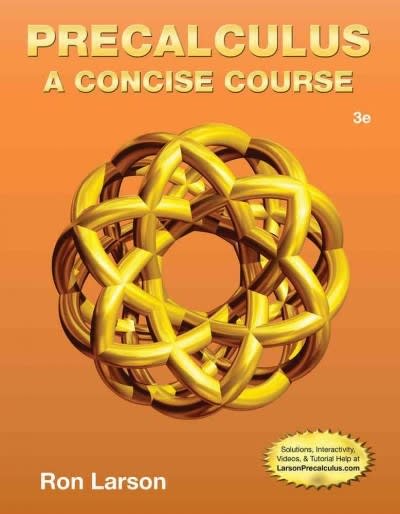Question
A new study to determine the effectiveness of winter flu vaccinations measures the benefits of a flu shot for school children. The study comprises two
A new study to determine the effectiveness of winter flu vaccinations measures the benefits of a flu shot for school children. The study comprises two random samples of school children who were vaccinated. One sample is from a primary school and the other from a high school.
Question 1
According to previous studies, 50% of vaccinated primary school children contract winter flu. If a study takes a random sample of 18 vaccinated primary school children, the probability that less than 4 children in the sample contract flu is
0.0038
0.0117
0.0154
0.6439
Question 2
For the random sample in Question 1, the probability that at least 4 children but no more than 8 children contract flu is
0.0154
0.2366
0.4035
0.5713
Question 3
The new study claims that the probability of contracting the winter flu among vaccinated high school children is less than 0.5. Assume that p is the population proportion of vaccinated high school children who contract the flu. The appropriate framework to test the new study's claim is
H0:p>0.5vsH1:p<0.5
H0:p=0vsH1:p0
H0:p=0vsH1:p>0
H0:p=0.5vsH1:p<0.5
Question 4
The new study takes a random sample of 14 vaccinated high school children. Let x be the number of children in the sample who contract the flu. The p-value for the test can be calculated from a Binomial distribution using P(Xx). The maximum number of children who can contract the flu to give evidence against the null hypothesis in Question 3 at the 5% level is
1
2
3
5
Question 5
Suppose the actual population proportion of vaccinated high school children who contract the flu is 30%. For a random sample of 14 vaccinated high school children and based on your answer to Question 4, the probability of making a Type II error is
0.3637
0.6448
0.8392
0.8631
Question 6
The new study also carried out a test to determine whether the population proportion of unvaccinated school children contracting winter flu was higher than the population proportion of vaccinated school children. The Z test statistic to test this belief is found to be 1.874. The corresponding p-value is
0.0305
0.1212
0.3036
0.7724
Question 7
Suppose that the new study uses a level of significance of 0.05 to test the claim in Question 6. The probability of Type I error is
0.025
0.05
0.95
0.975
Question 8
Based on previous studies of school children who were vaccinated and contracted the flu, the time in hours that the flu symptoms last is assumed to follow a normal distribution with a mean of 20.7 hours and a standard deviation of 7.3 hours. The probability that a randomly selected school child has flu symptoms for more than 24 hours is
0.1628
0.3256
0.6744
0.8372
Question 9
Suppose that a random sample of 5 vaccinated school children is taken. Assuming the distribution in Question 8, the probability that the mean time with symptoms is less than 18 hours is
0.2041
0.3557
0.6354
0.7959
Question 10
The researcher conducting the new study believes that the mean time with flu symptoms tends to be greater than 20.7 hours for unvaccinated school children. She takes a random sample of 10 unvaccinated children who contracted flu and records their times with symptoms. The appropriate non-parametric test the researcher should use is the
Wilcoxon Rank-sum test
Chi-square test
Sign test
F test
Step by Step Solution
There are 3 Steps involved in it
Step: 1

Get Instant Access to Expert-Tailored Solutions
See step-by-step solutions with expert insights and AI powered tools for academic success
Step: 2

Step: 3

Ace Your Homework with AI
Get the answers you need in no time with our AI-driven, step-by-step assistance
Get Started


